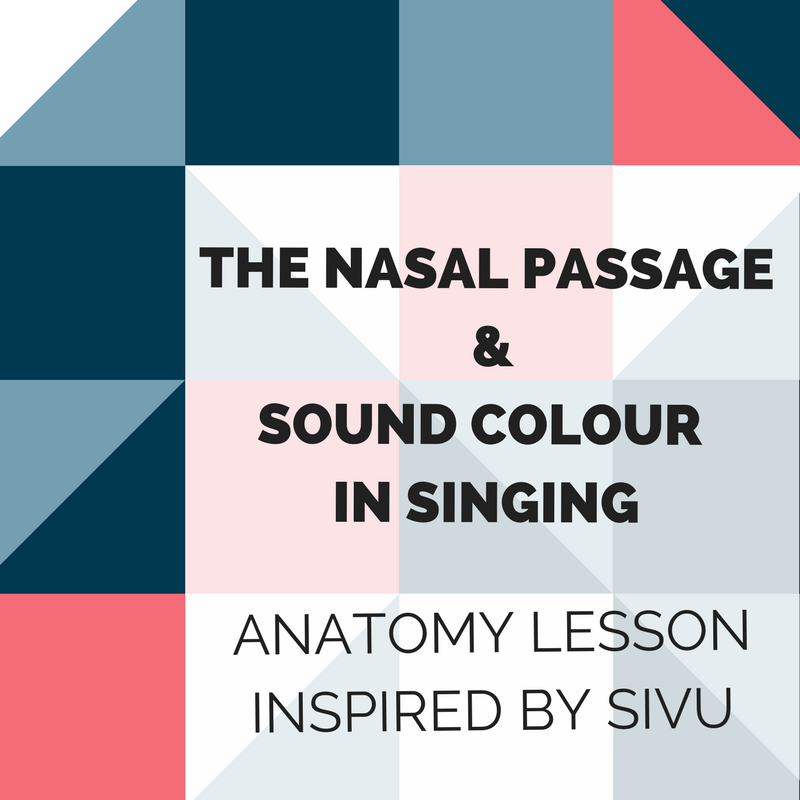
This anatomy and physiology resource for singers and singing teachers is a real piece of art! The music video for “Better Man Than He” by British singer-songwriter Sivu is created with MRI-images of Sivu singing. The video gives you a fantastic glimpse into the complicated movements of the vocal system during singing!
Inspired by the video, I wrote a little anatomy lesson for all you singers and singing teachers.
In this lesson I’d like to zoom in on the soft palate, uvula and nasal passage.
These parts, how they move, and how that in turn affects the sound, sometimes tend to create confusion in singers. So let’s study them with the help of this marvelous music video!
THE HARD PALATE, SOFT PALATE AND UVULA
The “roof” of the mouth is a bony area called the hard palate. It extends into a soft, non-bony area: the soft palate. The soft palate forms a muscular arch and ends in the uvula, a small piece of soft tissue that hangs down from the end of the soft palate. The soft palate and the uvula are movable.
NASAL PASSAGE
The doorway between the mouth and the nose is called the nasal passage, or nasal port. This doorway can be opened or closed with the uvula. When we swallow, muscles draw the soft palate and the uvula upward, which closes the nasal passage and prevents food or liquids from enter in the nasal cavity.
FINDING THE SOFT PALATE / UVULA AND NASAL PASSAGE IN THE VIDEO
At 0:15 in the video, look at the tongue. It is a big muscle filling up almost the whole oral (mouth) cavity. On top of the tongue there is something hanging down, touching the lower back part of tongue. This is the soft palate relaxing. Notice how the “tube” of the vocal tract reaches straight up towards the nasal cavity, when the soft palate and uvula are drooping down. The nasal passage is now open, allowing the air/sound into the nose. Your nasal passage is open for example when you say “ng” (as in “sing”). In fact, ALL sound comes out through the nose when you say “ng”, because the soft palate is down and touching the tongue, blocking the sound from entering the oral (mouth) cavity. Try this: say “ng” and pinch your nose. The sound and breath stops.
OPENING AND CLOSING THE NASAL PASSAGE
When Sivu proceeds to singing “lo-lo-lo…”, you can see the soft palate pulling up and back onto the back wall off the pharynx. The uvula closes the nasal passage, which in turn stops the sound from going into the nose. If you could pinch his nose now, the sound would not change at all, because all of it is coming out through the mouth.
Now Sivu continues singing the lyrics “you can end this anytime you want to”. Notice the soft palate/uvula moving back and forth, opening and closing the nasal passage. This is what is happening all the time when we speak or sing. When we speak or sing words that contain nasal consonants such as “n”, “m” or “ng”, the nasal passage is open. If the nasal passage would be closed all the time, we could not produce nasal consonants and it would sound rather strange!
When we sing (or speak) vowels, we have a choice: the nasal passage can be either closed or open.
The nasal passage is open for example at 03:03. Notice how the soft palate is relaxed and hanging downwards. You see both cavities, the oral (mouth) cavity and the nasal cavity, are open. The sound now comes out of the nose as well as the mouth, and becomes nasalised in character. Remember the nose pinching test? If you sing a vowel sound with an open nasal passage, the sound will not stop but it will change sound color.
Can you follow it so far?
Here’s the video one more time, to make it easier for you to read the lesson and play the video as you read on:
THE NASAL PASSAGE AND SOUND COLOUR
Some singers use an open nasal passage to affect the sound colour.
At 01:14 when Sivu sings “doom”, the nasal passage is open. If you listen to the vowel sound in the word “doom” you can hear that it is nasal.
Compare this to when he sings “lo-lo-lo…” at 0:17, where the soft palate has pulled up, and the uvula is closing the nasal passage. Now the sound cannot travel up to the nasal cavity, and it is coming out only from the mouth. When the nasal passage is closed, the sound becomes more powerful and the sound colour darkens.
How much the sound should be nasalised in singing is an artistic choice.
SOME FINAL THOUGHTS
You might think, “So if nasality is an artistic choice, why would I bother practicing singing with a closed nasal passage?” Remember, if ALL your vowels are nasalised because you are unable to close the nasal passage with the uvula all together during singing, we are not talking about a “choice”!
It makes a lot of sense to practice closing and opening the nasal passage, because this will give you more control over your instrument and more options in sound. If you cannot close your nasal passage when you are singing, you could lose a considerable amount of resonance. The oral cavity is bigger than the nasal cavity, so it is a more efficient resonator. There are also other benefits of gaining control over the nasal passage, such as breath efficiency.
I hope you enjoyed this anatomy lesson!
Although I chose to use the music video as a teaching tool, please do also watch it for pure enjoyment. Enjoy the music and singing of Sivu, marvel at the artistry of director Adam Powell who created the music video, and the wonders of the human voice!
©2013 Katja Maria Slotte

Pingback: Online Vocal Anatomy & Physiology Resources For Singers